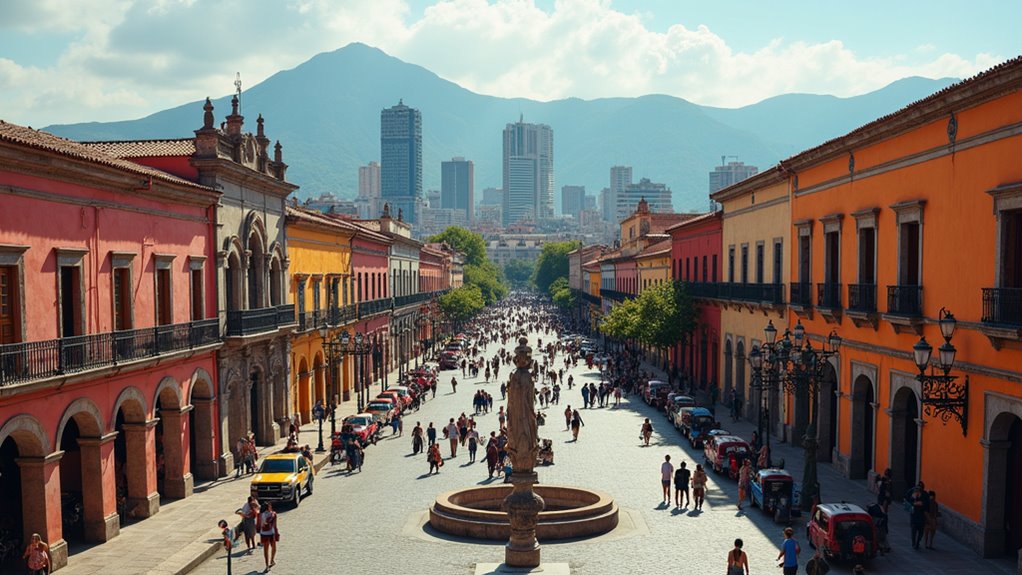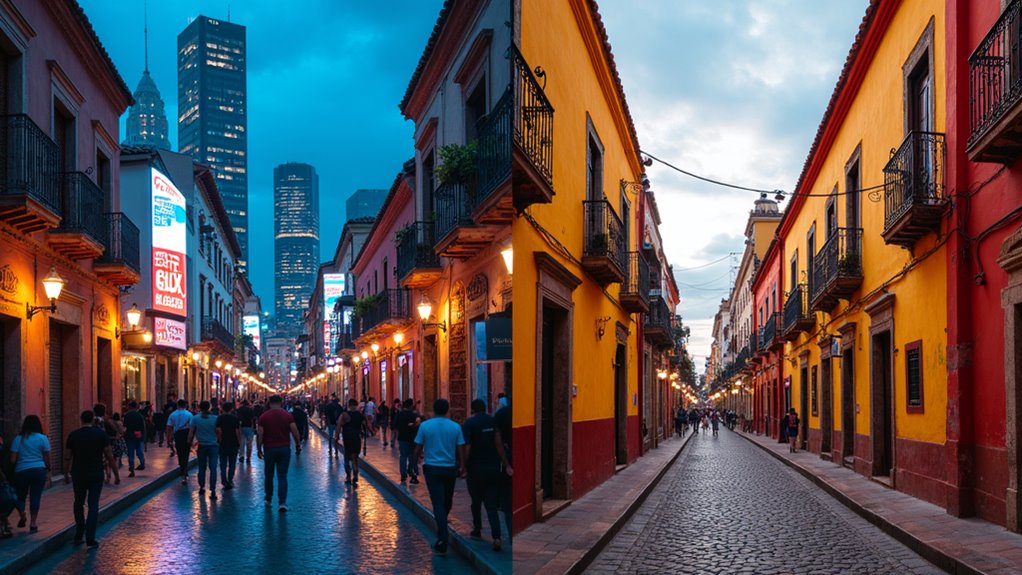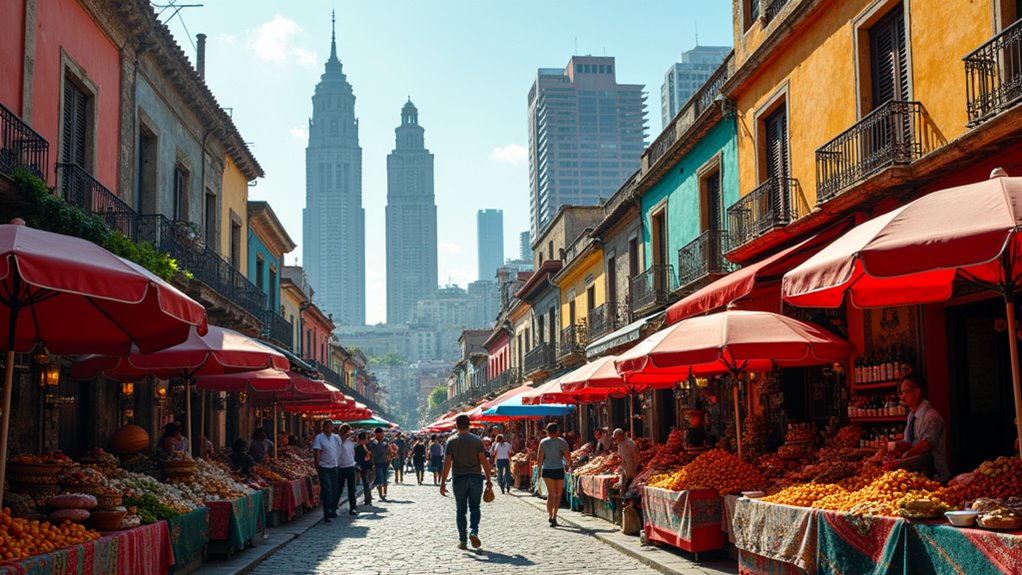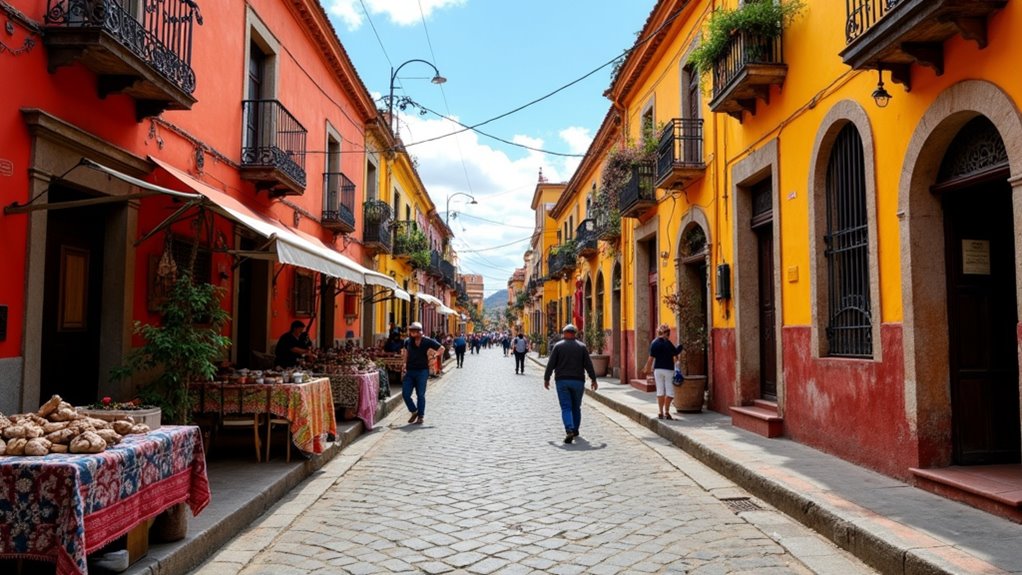Physical Address
304 North Cardinal St.
Dorchester Center, MA 02124
Physical Address
304 North Cardinal St.
Dorchester Center, MA 02124

Uncover the captivating contrast between Mexico City's pulsating modernity and Oaxaca's serene cultural allure, as you decide which Mexican city steals your heart.
Choosing between Mexico City and Oaxaca is like deciding whether to experience the vibrant pulse of a bustling modern metropolis or the serene charms of a historic cultural haven. You’ll find world-class museums, diverse cuisines, and an enchanting blend of ancient and contemporary influences in both destinations. But what sets them apart might surprise you and leave you wondering – which Mexican city will capture your heart?

Although Oaxaca and Mexico City share deep historical roots in ancient Mesoamerican civilizations, the two cities have distinct cultural heritages that manifest in different ways.
Oaxaca maintains stronger ties to its pre-Hispanic Zapotec and Mixtec traditions, with ongoing cultural practices and UNESCO-listed historic sites. Mexico City represents modern Mexico, blending ancient and contemporary cultures with a youthful vibe. In contrast, Mexico City’s history is layered, evolving from the Aztec capital of Tenochtitlán to a modern metropolis.
Both cities showcase their architectural legacies, from Oaxaca’s colonial churches to Mexico City’s avant-garde skyscrapers. However, their cultural expressions also diverge, with Oaxaca’s focus on traditional arts and crafts versus Mexico City’s thriving contemporary art scene and culinary innovations.
When comparing the two cities, the overall cost of living in Mexico City is generally higher than in Oaxaca.
Housing, dining, and basic commodity prices are all markedly more affordable in Oaxaca. For example:
That said, transportation costs may be slightly higher in Mexico City, though the difference isn’t as pronounced as in other spending categories.

Both Mexico City and Oaxaca offer diverse and enchanting culinary scenes, though each city showcases distinct regional specialties and cultural influences.
Oaxacan cuisine is renowned for traditional dishes like mole negro and tlayudas, while Mexico City reflects a more cosmopolitan blend of international and local flavors. Street food is popular in both cities, but Oaxaca’s focus on local ingredients is particularly notable. Oaxaca is considered the gastronomic heart of Mexico, famed for its native produce, artisanal cheese, and mezcal.
Oaxacan cuisine is renowned for traditional dishes like mole negro and tlayudas, while Mexico City reflects a more cosmopolitan blend of international and local flavors.
Meanwhile, Mexico City’s vibrant culinary landscape offers a wide range of culinary experiences, from historic markets to floating markets.
Whether you seek traditional fare or global influences, both destinations promise a delectable exploration of Mexican cuisine. [Mexico City also features a diverse array of Michelin-starred dining experiences.
Oaxaca and Mexico City offer an array of enchanting historical, cultural, and natural attractions that provide visitors with immersive experiences.
Iconic sites like the Oaxaca Cathedral, Church of Santo Domingo de Guzmán, and Monte Albán allow you to investigate the region’s abundant heritage. Both cities provide first-rate museums and historical experiences, with Mexico City boasting world-renowned museums such as the National Museum of Anthropology and the Palace of Fine Arts.
Outdoor enthusiasts can explore natural wonders like Hierve el Agua near Oaxaca and the Chapultepec Park in Mexico City. Oaxaca’s worth visiting status is further elevated by its reputation as a top travel destination in Mexico for authentic cultural experiences. Plus, both destinations offer unique day trip opportunities, from the indigenous culture of Mitla and Teotitlán del Valle to the charming towns of Puebla and Taxco.

Although Mexico City and Oaxaca differ vastly in population size, their unique urban landscapes and transportation networks present distinct accessibility factors for visitors.
With over 12 million residents, Mexico City’s sprawling Metro system and international airport contrast with Oaxaca’s more compact, pedestrian-friendly historic center and regional airport. Mexico City’s population of over 9 million makes it the most populous municipality in Mexico. While Mexico City’s highways and diversified economy offer greater nationwide connectivity, Oaxaca’s mountainous terrain and reliance on tourism provide easier access to nearby coastal and ecotourism attractions.
Both cities, however, face uneven accessibility for disabled travelers. Travelers often find themselves torn between Oaxaca’s charm and Mexico City’s extensive amenities when deciding which destination better suits their travel preferences. Ultimately, each destination’s scale and transportation networks shape the visitor experience in profoundly different ways.
Mexico City’s vibrant cultural scene enchants visitors, offering a diverse array of museums, historical landmarks, and lively parks. You can learn about the city’s affluent cuisine, from traditional tacos al pastor to the complex flavors of mole poblano.
Nightlife abounds in trendy neighborhoods like La Condesa and Roma, where you’ll find an array of bars and clubs.
In contrast, Oaxaca enthralls with its Indigenous heritage, historic architecture, and renowned culinary offerings like mezcal tastings. The city’s festivals and celebrations, such as Día de los Muertos, provide a unique cultural experience. Tourism is a major industry within Mexico’s economic landscape, contributing significantly to the economy.
Whether you seek urban energy or a more intimate culture, both Mexico City and Oaxaca offer distinct tourism experiences.

With its affluent cultural heritage and immersive experiences, Oaxaca offers distinct advantages for those seeking a profound culture. Cultural immersion enhances understanding of diverse health views and facilitates better quality care in multicultural settings. The city celebrates vibrant festivals, showcasing traditional dance, music, and cuisine. Interactions with indigenous communities like the Zapotec and Mixtec provide valuable opportunities for language exchange and learning about local practices. Oaxacan art forms, including woodcarvings and textiles, are readily accessible. The historic city center immerses visitors in the colonial past. Educational programs offer in-depth study of bio-cultural diversity, Mexico’s social issues, and Oaxacan culture. While Guadalajara also offers cultural experiences, Oaxaca provides unique allure through its deeply preserved indigenous traditions. Community engagement projects allow participants to contribute to local development in meaningful ways. Oaxaca’s smaller size and surrounding natural wonders further enhance the culture experience.
Teeming with a population of over 22.75 million, Mexico City serves as the largest city in the Western Hemisphere. Its urban sprawl encompasses a sprawling 1,485 km². Recent increase of 247,100 in the last year has contributed to the city’s growing population.
With $1.13 billion invested in infrastructure upgrades, the city boasts:
The city’s cultural wonders make it an essential destination for travelers seeking to experience Mexico’s rich heritage and contemporary urban life.
You’ll be blown away by the vibrant diversity of Mexico City, but Oaxaca will captivate your senses with its deep-rooted traditions. Whether you crave the cosmopolitan energy or seek culture, both cities offer unforgettable experiences that’ll leave you craving more of Mexico’s luxurious tapestry. Ultimately, your choice depends on your travel preferences – so explore the sights, sounds, and flavors of these remarkable destinations.